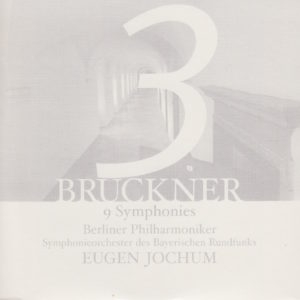 This morning’s conductor of Anton Bruckner’s Symphony No. 3 in D Minor (WAB 103), nicknamed “Wagner,” is German-born Eugen Jochum (1902-1987), unarguably one of the most highly respected interpreters of Anton Bruckner’s music who ever lived. The orchestra is the Symphonieorchester des Bayerischen Rundfunks.
This morning’s conductor of Anton Bruckner’s Symphony No. 3 in D Minor (WAB 103), nicknamed “Wagner,” is German-born Eugen Jochum (1902-1987), unarguably one of the most highly respected interpreters of Anton Bruckner’s music who ever lived. The orchestra is the Symphonieorchester des Bayerischen Rundfunks.
I encountered Mr. Jochum four times before in my 144-day journey: on Day 6, Day 7, Day 23, and Day 22.
I could spend a lot of time talking about America’s presidential election and the seriously misguided people protesting the results of it (where would they rather live – in a banana republic where violent overthrows are commonplace?). But I’d rather not. My motto is: “Let stupid people lie.”
So, it’s time to dive into the nuts and bolts of this morning’s recording:
Bruckner’s Symphony No. 3 in D Minor, composed in 1873
The version Jochum used is the 1877/78 version, edited by Nowak
Eugen Jochum conducts
Symphonieorchester des Bayerischen Rundfunks plays
The symphony clocks in at 53:16
This was recorded in January of 1967 in Munich, Germany
Jochum was 65 when he conducted it
Bruckner was 49 when he composed it
This recording was released on the Deutsche Grammophon Record Label
Bruckner wrote his symphonies in four parts. The time breakdown of this one (Symphony No. 3 in D Minor, 1877/78 Nowak version), from this particular conductor (Jochum) and this particular orchestra (Symphonieorchester des Bayerischen Rundfunks) is as follows:
Moderato (Mehr langsam, misterioso, officially)………………………….20:05
Adagio (Bewegt, quasi Andante, officially)…………………………………….15:18
Scherzo…………………………………………………………………………………………….7:15
Finale………………………………………………………………………………………………10:37
Total: 53:16
Okay. Now for the subjective stuff…
My Rating:
Recording quality: 5
Overall musicianship: 5
CD liner notes: 5 (two essays – one titled “The Development of Bruckner’s Symphonic Style” by Constantin Floros, and one by Eugen Jochum called “The Interpretation of Bruckner’s Symphonies” translated into English, German, and French)
How does this make me feel: 5
I was drawn in from the first notes in the first movement…and held the entire time – all 53:16 of it.
What is it that differentiates one recording over another? Why can I listen to one of these symphonies one day and think it’s sub-par, and listen to the same symphony, by a different conductor and orchestra another day and think it’s angels singing me into heaven?
What is that difference?
How it was recorded/engineered? The skill of the orchestra? The passion and insight of the conductor? The age of the recording? The version used?
What is it?!?!?!?
Does anyone know?
Is it purely subjective? Is it all in the ears of the listener? Or is there something objective about this process that determines whether or not a recording resonates with someone?
Here’s what I know for a fact: This is beautiful music, exceptionally well recorded, played with uncommon skill and passion. Plus, the box set is typical for the DG label. Class all the way.
Three thumbs up.
